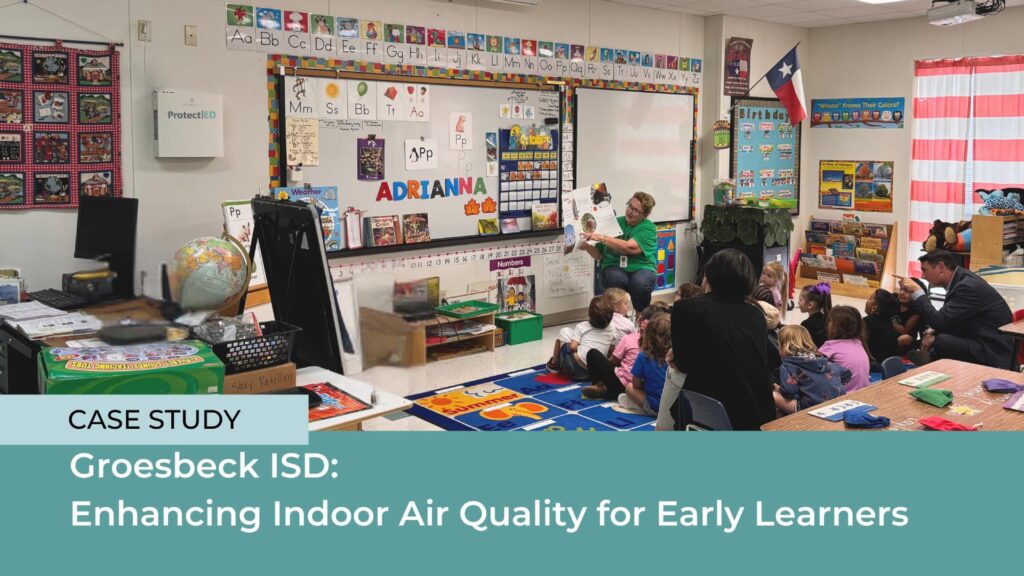Main Menu


Groesbeck Independent School District (GISD), located in Central Texas, serves approximately 1,600 students across five campuses. With a strong commitment to providing a top-tier education, the district emphasizes the importance of optimal learning environments, especially for its youngest students in Kindergarten, PreK, and daycare programs. Early education is crucial for developing social, emotional, and cognitive skills, including language development and self-regulation, which lay the foundation for future academic success. Additionally, these programs promote equity by ensuring all children have access to early learning opportunities.
GISD recognized the significant role of maintaining healthy indoor air quality in supporting early learners. By ensuring a clean, safe indoor environment, the district aimed to foster an environment where young minds can flourish, which also helps increase and sustain enrollment in these programs.
In 2020, like many districts across the nation, GISD invested in air purifiers that required frequent filter replacements. However, when filters became scarce due to increased demand, the devices were no longer effective, leaving classrooms with subpar air quality. This issue was particularly concerning in the district’s early childhood classrooms and daycare, where the youngest and most vulnerable learners, along with the children of district employees, spend their days.
Poor indoor air quality (IAQ) posed multiple risks, including:
Children, especially those in early learning environments, are known drivers of respiratory virus transmission due to frequent close contact and low immunity. This increased the risk not only within school walls but also in the broader community.
To address these challenges, GISD partnered with Protect|ED, a leading provider of Indoor Air Quality (IAQ) solutions for education spaces. Together, they implemented the medical-grade air disinfection technology NanoStrike™ in GISD’s early childhood classrooms and daycare facilities.
NanoStrike technology, originally developed for healthcare settings such as neonatal ICUs, eliminates airborne viruses, bacteria, and mold spores. This innovative solution was selected for its proven efficacy in healthcare environments and adapted for use in schools to ensure the air quality met the highest standards. Protect|ED has deployed NanoStrike in schools across the United States, helping to protect the health of students and staff in a variety of educational environments.
Key advantages of NanoStrike technology include:

Following the installation of NanoStrike in its early childhood learning spaces, GISD experienced several positive outcomes:
The success of NanoStrike air disinfection technology in Groesbeck ISD’s early childhood spaces has been clear: improved attendance, enhanced wellness for students and staff, and a healthier learning environment.
As one teacher noted,
“For the first time, Kindergarten attendance is at 98%, which is huge for October—usually the month where viruses spread.”
By creating safer environments for young students, GISD is not only protecting its current students but also setting the stage for long-term academic success. As a result, the district is working with Protect|ED to explore opportunities to expand NanoStrike technology across all campuses.
For other schools seeking to enhance air quality, GISD’s experience offers a compelling case for adopting NanoStrike technology. With Protect|ED already deploying this solution in schools throughout the U.S., it’s clear that protecting students’ health through advanced IAQ solutions is an investment in their future—a future where learning continues uninterrupted, and schools remain safe havens for students, teachers, and staff alike.
Shonuh Jackson, a third-year teacher at GISD with over 23 years of experience, shared:
“January and October are usually the months where viruses spread, but I noticed we don’t have as many students out. I may have one or two here and there, as opposed to half of the class.”
“Normally my voice changes in October, when the weather changes, and I haven’t lost my voice yet—and that’s a big thing. You need your voice in Kinder.”
The results speak for themselves: clean air in schools makes a difference.
Receive customized consultation and information about using Protect|ED air quality products in your facilities.